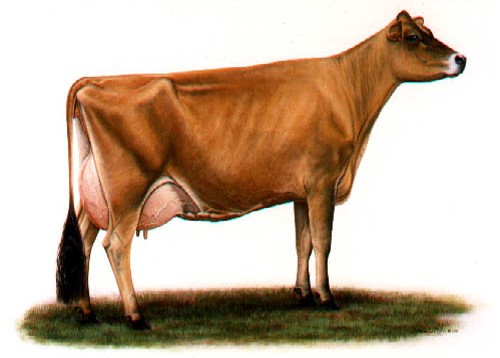The Jersey breed originated on the Island of Jersey, located in the English Channel between France and England. The Jersey is one of the oldest dairy breeds, having been cultivated for nearly 600 years. The first Registered Jerseys were imported to America in 1850, but purebred Jersey cows had been imported much earlier. Today, Jerseys are an important part of the dairy industry in the United States and are reported to be the most widely distributed dairy breed in the world.

The ideal Jersey cow
Jerseys are the best choice for sustainable dairying, using an average of 32% less water and 11% less land. Because Jersey dairies use less fossil fuels and have lower waste output, they have a 20% smaller carbon footprint. For more information, see our Sustainability Research page.
Milk produced by Jersey cows tastes great. It has a creamy, smooth and satisfying flavor and contains more protein, calcium, and other vital nutrients than does milk from other dairy breeds (see our Nutrition Information page for test results from individual producers). The Jersey is the most efficient dairy producer in the world, producing more pounds of milk or pounds of cheese per pound of body weight than any other breed. An average Jersey in the United States produces 18 times her body weight in milk each year. The Jersey production champion produced 41 times her body weight in one year: 55,590 lbs. milk containing 1,796 lbs. protein. That is equal to 6,201 lbs. of cheese, enough to make almost 100,000 cheeseburgers.
Jersey calves weigh about 55 pounds when born. The typical weight for mature Jerseys is about 950 pounds for females and 1,500 pounds for males. While they are usually fawn-colored, Jerseys can also have white markings or be almost black. Their noses are black with a white ring above the nose, and their hooves are black. Jerseys reach maturity the earliest of all dairy breeds, are efficient reproducers and have longer productive lives.
Jerseys are adapted to a wide range of climatic and geographical conditions. Herds of Jerseys can be found from Denmark to New Zealand, from Canada to South America, and from South Africa to Japan. An outstanding feature of Jerseys is that they are more tolerant of heat than the larger breeds.
The American Jersey Cattle Association was organized in 1868 to improve and promote the breed of Jersey cattle in the United States. It is located at 6486 E. Main Street in Reynoldsburg, Ohio 43068. For more information, read Why Jerseys, visit the AJCA website, or connect with us on Facebook.